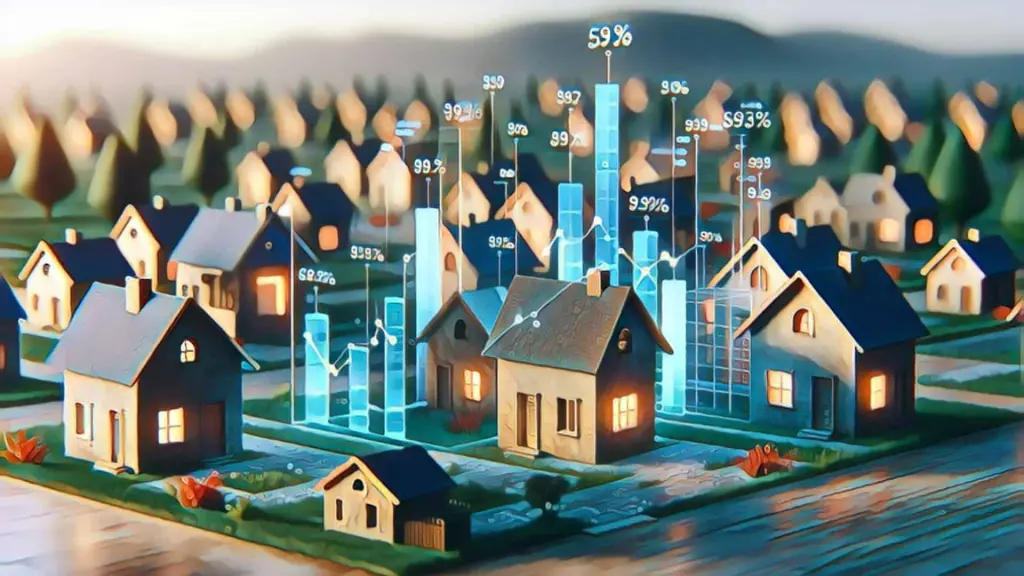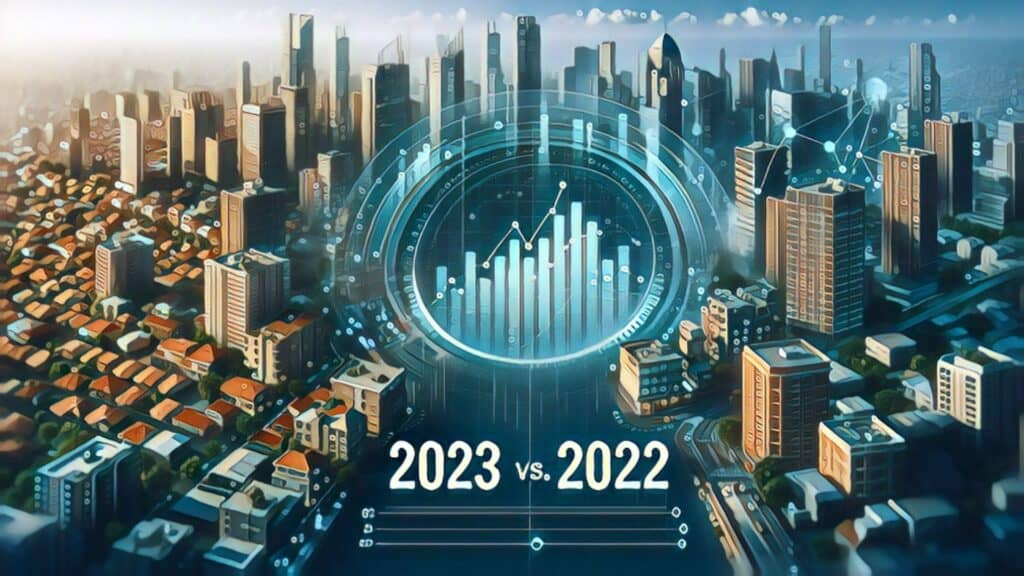Key Takeaways:
- Home prices are predicted to fall slightly in 2024, marking a shift towards a more buyer-friendly market.
- The real estate industry is undergoing significant changes, with innovations in how properties are bought and sold.
- Regional variations are significant, with coastal areas facing price declines due to climate risks, while inland regions may see price rises.

Introduction: 2023 Real Estate Market vs. 2022 Correlation (Predictions and Insight for Investor Readiness)
As we jump head-first into the concluding state of the 2023 real estate market, it’s imperative to draw a comparison with 2022 to understand the evolving dynamics.
This year has brought about significant changes, influenced by various economic factors, impacting everything from mortgage rates to housing demand.
Let’s move forward on this analytical journey to glean insights crucial for investor readiness in the ever-changing real estate market.
Overview of the 2022 Real Estate Market
The year 2022 was a pivotal period in the real estate sector, marked by unique challenges and opportunities.
The market saw significant movements in mortgage rates, influencing buyer and seller behaviors.
As we analyze the data, including home sales and price gains, it becomes clear that 2022 sets the stage for the trends we observe in 2023.
Understanding these year-over-year changes is essential for grasping the current market scenario.
The Shift into 2023: Key Changes and Continuations
Transitioning into 2023, the real estate market carried forward some trends from 2022 while also introducing new dynamics.
The interplay between rising mortgage rates and the demand for housing continued to shape the market.
Additionally, factors like the job market and real estate investment strategies began to show their impact.
This period marks a significant juncture, where understanding the shifts becomes crucial for real estate agents, investors, and home buyers alike.

Housing Market Analysis: 2022 in Review
Reflecting on 2022 offers critical insights into the current state of the real estate market.
The year served as a foundational period, setting the stage for the trends and changes we’re witnessing in 2023.
Let’s take a closer look at the key elements that define the 2022 housing market.
Home Price Trends in 2022
The story of home prices in 2022 is one of significant interest, marked by both growth and challenges.
Median home prices witnessed fluctuations influenced by factors such as mortgage rates, housing inventory, and buyer demand.
Year-over-year, these changes provided a clear picture of the market’s health.
Understanding these price dynamics is crucial for anyone looking to enter the market, whether as a buyer, seller, or investor.
Interest Rate Impacts on the 2022 Market
Interest rates played a pivotal role in shaping the 2022 real estate landscape.
The relationship between mortgage rates and home prices was particularly evident, as changes in the former directly impacted buyer affordability.
This interplay affected everything from the pace of home sales to the overall housing demand, making it a key factor in any market analysis.
Housing Inventory and Affordability in 2022
The availability of homes for sale and their affordability were central themes in 2022.
Housing inventory levels, influenced by factors like new constructions by home builders and the decisions of existing homeowners, had a direct impact on market dynamics.
Affordability, tied closely to mortgage rates and income levels, remained a critical concern, shaping the decisions of potential home buyers and influencing the overall health of housing markets.
| 2022 Housing Market Statistics | Data |
|---|---|
| Median Home Value | $357,589 |
| Median List Price | $388,300 |
| 1-Year Appreciation Rate | 13.5% |
| Median Home Value Forecast (Next Year) | 1.2% |
| Homes for Sale (Year Over Year) | 1,067,148 (8.2% increase) |
| New Listings (Year Over Year) | 354,640 (9.9% decrease) |
| Homes Sold (Year Over Year) | 311,761 (26.5% decrease) |
| 30-Year Fixed Mortgage Rate | Expected to rise to 3.5% (from 3% in 2021) |
| Existing-Home Sales (2022) | 5.9 million (slight decrease) |
| New House Price Increase | Higher rate than existing home prices |
| Housing Transactions (2022) | 5 million (down from 6.12 million in 2021) |

2023 Real Estate Market Trends and Changes
As we transition into 2023, the real estate market unfolds with new trends and ongoing shifts from the previous year.
These developments are crucial for understanding the current market dynamics and making informed decisions.
Market Predictions at the Start of 2023
The onset of 2023 was met with various market predictions, reflecting the anticipation of real estate experts and economists.
These predictions, based on analyses of trends like mortgage rates, home sales, and economic indicators, set the tone for the year.
They offer valuable insights into what to expect, particularly in terms of home price changes, demand for housing, and the overall market trajectory.
July 2023: Mid-Year Review and Home Price Insights
By July 2023, the real estate market had begun to reveal its direction for the year.
This mid-year review is crucial for understanding the year-over-year changes, including the rise or decline in home prices and the factors influencing these trends.
Insights gleaned from this period are essential for real estate investors, agents, and home buyers to adapt their strategies in a dynamic market.
The Role of Online Real Estate Platforms in 2023
Online real estate platforms have continued to play a significant role in 2023.
These platforms have not only transformed the way properties are listed and viewed but also how market data is analyzed and disseminated.
Their impact on the real estate landscape, particularly in terms of accessibility to real estate data, market predictions, and the ease of connecting buyers and sellers, has been profound.
2023 Real Estate Market Recap Analysis
Existing-Home Sales (2023):
- Sales fell nearly 19.1% from 2022.
- Sales fell about 33.5% from 2021.
Mortgage Rates:
- Rates started in the mid-6% range.
- Rates topped 7% in fall 2022.
- By early March of 2023, rates had topped 7%.
- By mid-October 2023, rates topped 8%.
- Rates came down into the low 7% range later in the year.
- Rates were up three-quarters of a percentage point from a year ago.
Home Listings:
- There were nearly 15.2% fewer new listings in the first 11 months of 2023 compared to the same period in 2022.
Home Prices (2023):
- Median home price increased by 2.1% year over year to $428,000.
- Prices started at a median of $403,333 in January and peaked at $445,000 in June.
- Prices fell to $420,000 by November.
Home Sales by Region (Year Over Year):
- Sales fell 19% in the South.
- Sales fell 20% in the Midwest.
- Sales fell 24% in the Northeast.
- Sales fell almost 26% in the West.
Rent Prices:
- Monthly rental prices increased by just $6 nationally from January through October.
- The typical rent reached $1,736 a month.
- Rental prices slipped slightly for the past six months in a row.
New Home Construction (2023):
- Housing starts dropped about 10% compared to the previous year.
- Builders began 2023 strong but waned in the second half of the year.
- Apartment construction remained strong in the outer suburbs and rural markets, but it fell in big cities and was flat in close-in suburbs.
—
Source: Realtor.com
These data points provide insights into the challenges and trends in the real estate market in 2023.

US Home Price Insights: 2023 vs. 2022
The comparison of home prices between 2023 and 2022 offers a window into the evolving real estate market. This section looks into how these prices have changed and the factors driving these shifts.
Comparative Analysis of Home Values
In 2023, the landscape of home values has been shaped by a myriad of factors, including mortgage rates, housing demand, and economic conditions.
A year-over-year comparison with 2022 reveals significant insights into the trends of median home prices, showcasing areas of growth, stability, or decline.
This analysis is crucial for understanding the overall health of the housing market and the potential for future price changes.
Interest Rates and Their Effect on Home Buyers
Interest rates, particularly for 30-year mortgages, have a profound impact on the real estate market.
Throughout the 2023 real estate market, these rates have continued to influence buyer behavior, affordability, and the decision-making process for potential homebuyers.
Comparing these rates with 2022 provides a clear picture of how changes in borrowing costs affect the market, from home sales to the overall demand for housing.
Affordability Challenges: 2022 vs. 2023
Affordability remains a key concern in the real estate market.
The year 2023 has brought its own set of challenges and opportunities in this regard, influenced by factors such as mortgage rates, income levels, and the price of homes.
A comparison with 2022 highlights the shifts in affordability, offering insights for buyers, sellers, and investors about the changing dynamics of the market.
2023 United States Housing Market Generalizations
Listing Activity (August 2023):
- Inventory of single-family and condominium homes for sale in August was just 1.03 million, down 8.3% from a year ago.
- Adjusted for seasonal variations, there were over 911,000 single-family homes for sale, down 15% from a year ago.
- Condominium listing activity was down year-over-year by just over 9%.
Homes for Sale (August 2023):
- The total number of units for sale in August 2023 was just over 1 million.
Sales Activity:
- Home sales plummeted in 2023 following the surge in 2021.
- Annual sales rate was 4.04 million units, only 40,000 more than the low seen in January.
- Home sales were holding at levels not seen since 2010.
- Single-family sales saw a small jump at the start of the year but pulled back later in the year.
- Condominium market, while down significantly, appeared somewhat more resilient.
Home Sale Prices (2023):
- U.S. home prices were only 1.6% below their 2022 peak.
- Home prices were up 3.9% year over year and up by 11.1% from the start of 2023.
- Single-family home prices were down by 1.8% from peak but up 3.7% year over year and up 11.2% from the start of the year.
- Condominium prices were just 0.1% below the high seen in June of the previous year.
- Condominium prices were up 6.2% year over year and 11.6% higher than at the end of 2022.
Price Growth vs. Payment Growth (2023):
- Mortgage payment growth sat at 26.5% while price growth was at 3.9%.
Home Price Forecast (October 2023 to November 2023):
- Home prices were expected to remain unchanged on a month-over-month basis (0.0%).
- Prices were projected to increase on a year-over-year basis by 2.9% from October 2023 to October 2024.
Home Price Growth by State (October 2023):
- Nationally, home prices increased by 4.7% year over year in October 2023.
- States with the highest increases year over year were Connecticut (10.3%), New Jersey (9.9%), and Rhode Island (9.7%).
Top Markets at Risk of Home Price Decline (October 2023):
- Cape Coral-Fort Myers, FL, was at very high risk of a decline in home prices over the next 12 months.
- Other markets at very high risk included Youngstown-Warren-Boardman, OH-PA; Atlanta-Sandy Springs-Roswell, GA; West Palm Beach-Boca Raton-Delray Beach, FL; and Deltona-Daytona-Beach-Ormond Beach, FL.
—
Sources: Windermere, Corelogic
These data points provide insights into the state of the U.S. housing market in 2023, including supply constraints, sales activity, price trends, and market risks.

United States Commercial Real Estate 2023 vs. 2022 Observations
As we shift our focus to the commercial real estate (CRE) sector, it’s essential to understand how this market segment has evolved from 2022 to 2023. This part of the real estate industry presents its own set of challenges and opportunities, distinct from the residential market.
| Commercial Real Estate Sector | Performance in August 2023 |
|---|---|
| Multifamily | |
| Units Delivered (Last 12 Months) | 32% increase compared to previous year |
| Vacancy Rate (August 2023) | 1.2% increase compared to last year |
| Absorption Rate (August 2023) | 23% surge compared to a year prior |
| Office | |
| Surplus Office Space (Last 12 Months) | 59.4 million sq. ft. unoccupied |
| Office Vacancy Rate (August 2023) | 13.3% (highest in 10 years) |
| Industrial | |
| Net Absorption (Last 12 Months) | 47% decrease compared to previous year |
| Additional Industrial Space (Last 12 Months) | 525 million sq. ft. added |
| Industrial Vacancy Rate (August 2023) | 5.4% |
| Rent Growth (August 2023) | 7.5% |
| Retail | |
| Rent Growth (12-Month Ending August 2023) | 3.2% (decreased by 1.2% compared to previous year) |
| Vacancy Rate (August 2023) | 4.2% (lowest among all CRE sectors) |
| Hospitality | |
| RevPAR (Revenue per Available Room) | More than 13% higher than pre-pandemic levels |
| ADR (Average Daily Rate) | About 18% higher than pre-pandemic levels |
| General Trends | |
| Impact of Interest Rate Hikes | Tightening of commercial real estate credit |
| Delinquency Rates for CRE Loans | Increased but historically low |
| Future Rate Hike Predictions | Pause in rate hikes to assess impact |
| Multifamily Outlook | |
| Factors Contributing to Strength | Favorable demographics, strong job market, low housing affordability |
| Office Outlook | |
| Challenges Faced | Surplus of 59.4 million sq. ft. unoccupied office space |
| Industrial Outlook | |
| Current State | Reverted to pre-pandemic levels with increased supply |
| Retail Outlook | |
| Rent Growth Trend | Decreased but still higher than pre-pandemic levels |
| Hospitality Outlook | |
| Recovery from Impact | Significant increase in RevPAR and ADR |
| Overall Outlook | |
| Continuing Trends | High vacancy rates, slower rent growth |
| Market Assessment | Pause in rate hikes to assess impact of higher rates |

Growth and Struggles
The year 2023 has been a mixed bag for the U.S. commercial real estate market.
While certain sectors have seen growth, others have faced struggles.
Factors such as changing work habits, remote work (eg: work from home), economic conditions, and market demands have played a significant role.
In contrast to 2022, where certain trends were just emerging, 2023 has been a year where the long-term effects of these trends have become more evident.
This includes shifts in office space demand, retail property adjustments, and the rise of e-commerce impacting warehouse and logistics properties.
Potential Solutions for the Changing CRE Landscape
Addressing the challenges and capitalizing on the growth opportunities in the commercial real estate market requires innovative solutions. In 2023, stakeholders are exploring various strategies to adapt to the evolving landscape. These include reimagining office spaces to cater to hybrid work models, repurposing retail properties for new uses, and investing in technology to enhance property management and tenant engagement. Comparing these solutions with the approaches taken in 2022 offers insights into the adaptability and resilience of the CRE market.
United States Real Estate Investor News
Commercial Real Estate Highlights
- The value of the Commercial Real Estate market is projected to reach US$24.67tn in 2023.
- The value is expected to show an annual growth rate (CAGR 2023-2028) of 2.70%, resulting in a market volume of US$28.18tn by 2028.
- In global comparison, most Real Estate value will be generated in the United States (US$24,670.00bn in 2023).
—
Source: Statistia

Forecasting the Real Estate Market: December 2023 Projections
As we approach the end of 2023, it’s crucial to look ahead and forecast the trends that will shape the real estate market. This forward-looking analysis helps stakeholders prepare for the upcoming year.
Analyzing Market Predictions and Trends
In December 2023, a pivotal moment for real estate market analysis emerges, as experts and analysts unveil their predictions for 2024.
These forecasts are grounded in a comprehensive analysis of 2023’s data, including home price trends, housing demand, and the trajectory of mortgage rates.
The insights drawn offer a roadmap for what the market might expect in 2024, with comparisons to actual 2023 data enhancing our understanding of market forecasting’s accuracy and the reliability of various indicators.
Key Trends for 2024
Home Prices Expected to Decline: In a notable shift, home prices are predicted to fall by 1% year-over-year in the second and third quarters of 2024, marking the first significant decline since 2012, aside from a brief period in early 2023.
Increase in New Listings: A rise in supply, outpacing demand, is anticipated, driven by a significant increase in homeowners seeking to sell. This uptick in listings is expected to stem from the easing of the mortgage-rate lock-in effect and a desire to sell before potential further price drops.
Rise in Home Sales: Home sales are forecasted to increase by 5% in 2024, gaining momentum throughout the year. This is in contrast to the trends seen in 2023, where sales were expected to slow down.
Mortgage Rates to Gradually Decline: Although remaining above 6%, mortgage rates are predicted to steadily decrease throughout 2024, dropping to around 6.6% by year’s end. This decline is attributed to the Federal Reserve’s likely rate cuts, starting in the summer.
Changes in the Real Estate Industry: The industry is poised for accelerated change in 2024. Trends include increased transparency in agent commissions and a shift towards buyers working directly with listing agents, potentially leading to cost savings.
Shift in Rental Market Dynamics: A growing demand for large rental apartments and houses is expected as more young families opt for renting over homeownership. This shift is partly due to high home prices and evolving perceptions of the American Dream among younger generations.
Impact on Presidential Election: Housing affordability, especially the rise in home prices since President Biden’s tenure, could become a significant factor in the 2024 presidential election. Policy proposals focusing on housing affordability are expected from both major political parties.
Regional Market Variations: Price changes are anticipated to vary by region, with significant declines in areas like coastal Florida due to factors such as climate risk, and increases in more affordable, climate-resilient metros.
Government Focus on Housing Affordability: Local and federal governments are likely to intensify their focus on making homes more affordable through various policies, including land-value taxes and encouraging new construction.
This analysis paints a picture of a real estate market in transition, where buyer-friendly conditions are emerging alongside industry changes and government focus on affordability.
However, challenges like high housing costs and regional disparities continue to shape the market’s dynamics.
Housing Market Crash: Myths and Realities
The potential for a housing market crash is a topic of considerable debate among experts.
As 2023 draws to a close, it’s important to differentiate between myths and realities regarding this possibility.
Factors like price declines, the risk for price declines, and overall market health are scrutinized to assess the likelihood of a housing market downturn.
This analysis is crucial for investors and buyers to make informed decisions.

2024 and Beyond: Real Estate Market Forecast
As we look towards 2024 and the future of the real estate market, it’s important to consider the long-term forecasts and trends that will shape the landscape.
This forward-looking perspective is vital for understanding the direction of the market and preparing for the changes ahead.
Early Predictions for 2024
The real estate market in 2024 is already shaping up with early predictions from experts and analysts.
These forecasts include expectations regarding mortgage rates, home prices, and the overall health of the housing markets.
Understanding these early predictions helps stakeholders, from real estate investors to home buyers, to strategize and make informed decisions for the year ahead.
The Future of Buying a Home: Trends and Expectations
Buying a home in 2024 may come with new trends and expectations, influenced by the evolving real estate landscape.
Factors such as the availability of homes for sale, interest rates, and the job market will play a crucial role in determining the ease and affordability of purchasing a home.
Keeping an eye on these trends helps prospective buyers to plan their steps and enter the market with confidence.
Annual Home Market Evolution: Long-Term Insights
The evolution of the annual home market provides long-term insights into the real estate sector.
By analyzing trends over the years, including home price growth, demand for housing, and changes in buyer and seller behavior, a clearer picture of the market’s trajectory emerges.
These insights are invaluable for understanding the future of real estate and making long-term investment decisions.

Assessment Into the New Year
As we assess the real estate market moving from 2023 into the new year, it’s crucial to review the trends and data that have defined the market.
This comprehensive assessment, incorporating insights from various months and market segments, provides a clearer understanding of where the market stands and where it’s headed.
September 2023: Market Reflections and Trends
In September 2023, the real estate market showcased specific trends that were indicative of the year’s overall performance.
Comparing data year-over-year, we observed shifts in the US housing market, particularly in large cities.
This period was marked by changes in annual home price growth, signaling the market’s response to various economic factors.
Real estate experts believe these trends provide valuable insights for predicting future market movements.
October 2023: Analyzing Market Shifts and Predictions
By October 2023, the market had further evolved, revealing new patterns in areas like single-family home sales and price changes.
This month’s data, juxtaposed with the same period in previous years, offered a unique perspective on the market’s trajectory.
Analyzing Year-Over-Year Trends: August to November 2023
The period from August to November 2023 was pivotal in understanding the year-over-year market changes.
During these months, the market experienced various shifts, including an increase in home prices and a fluctuation in buyer demand.
This period was crucial for assessing the overall health of the market, including the risk of a decline in certain segments.
The State of the 2023 Real Estate Market
Throughout 2023, the real estate market demonstrated resilience and adaptability.
From the spring of 2023 to the third quarter, we saw significant developments, including revisions with public records data and newly released public data.
These updates have provided a more accurate and comprehensive view of the market, informing decisions for buyers and sellers alike.
Future Projections: Home Price Growth and Market Health
As we look towards the future, it’s essential to consider the latest trends and projections for home price growth.
The CoreLogic HPI forecast indicates that home prices are anticipated to continue evolving, influenced by factors such as mortgage qualification criteria and market demand.
References
- Bank of America [1]
- Bankrate [1]
- CoreLogic [1] [2]
- CRE [1]
- Deloitte [1]
- Forbes [1]
- Fortune Builders [1]
- Freddie Mac [1]
- FHFA [1]
- JCHS Harvard [1]
- JLL [1]
- JP Morgan [1]
- ManageCasa [1]
- Mashvisor [1]
- NAR Realtor [1] [2] [3]
- Newsweek [1]
- Norada Real Estate [1] [2]
- PwC [1]
- Ramsey Solutions [1]
- Real Wealth [1]
- Realtor.com [1] [2]
- Redfin [1]
- Rocket Mortgage [1]
- ScienceDirect [1]
- Statista [1] [2]
- The Zebra [1]
- UBS [1]
- US News Real Estate [1]
- William Pitt [1]
- Windermere [1]
No related posts.




























